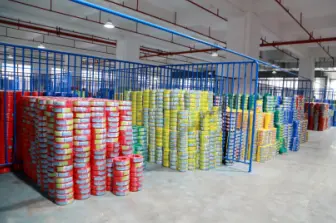What Is the Difference between Low Smoke Zero Halogen Cables and Ordinary Cables?
Flame-retardant cable refer to a cable whose sample is burned under specified experimental conditions and the flame spreads only within a limited range after the removal of the test flame source. Also, they are the cables whose residual flame or residual burn can be extinguished by itself within a limited time.
According to different cable flame-retardant materials, flame-retardant cables are divided into two categories: halogen-containing flame-retardant cable and low smoke zero halogen flame-retardant cable.
Among them, the insulation layer, sheath, outer sheath and auxiliary materials (belting and filling) of the halogen-containing flame-retardant cables ( that are ordinary cables) are all or partly made of halogen-containing polyethylene (PVC) flame-retardant materials, so they have good flame retardant properties. However, when the cables burn, a large amount of thick smoke and halogen acid gas will be released. The halogen acid gas is corrosive to the surrounding electrical equipment. Therefore, rescuers need to wear gas masks to approach the scene to extinguish the fire. When the cables burn, it will cause harm to the surrounding electrical equipment and rescuers, which is not conducive to the fire fighting and rescue work, so that results in serious "secondary hazards".
While, the insulation layer, sheath, outer sheath and auxiliary materials (tape and filling) of low-smoke zero halogen flame-retardant cables are all or partly made of halogen-free cross-linked polyethylene (XLPE) flame retardant materials, which not only have better flame-retardant properties, but also no halogen acid gas is released when the cables burn. What’s more, the amount of smoke generated by the cables is also small, which is close to the recognized "low smoke" level.
The following differences between the two should be paid attention to in the selection:
1. Since halogen-containing flame-retardant cables (including flame-retardant cables, low-halogen and low-smoke flame-retardant cables) will release corrosive halogen acid gas when burning, which greatly hinders fire fighting work, so that delays fire fighting time and aggravates the spread of fire. Therefore, public places with high population density should try to design and use low smoke zero halogen cables.
2. Any kind of flame-retardant cable can be used in the operation area with low population density.
3. Compared with halogen-containing flame-retardant cables, low smoke zero halogen cables have the advantages of low corrosion and low smoke, but their electrical and mechanical properties are significantly reduced. Therefore, when laying cables, low smoke zero halogen cables should have a larger bending radius than halogen-containing flame-retardant cables.
Latest News & Blog
 English
English  français
français  Deutsch
Deutsch  العربية
العربية  tiếng việt
tiếng việt  ไทย
ไทย  čeština
čeština  Indonesia
Indonesia  Eesti
Eesti  български
български  slovenčina
slovenčina 



